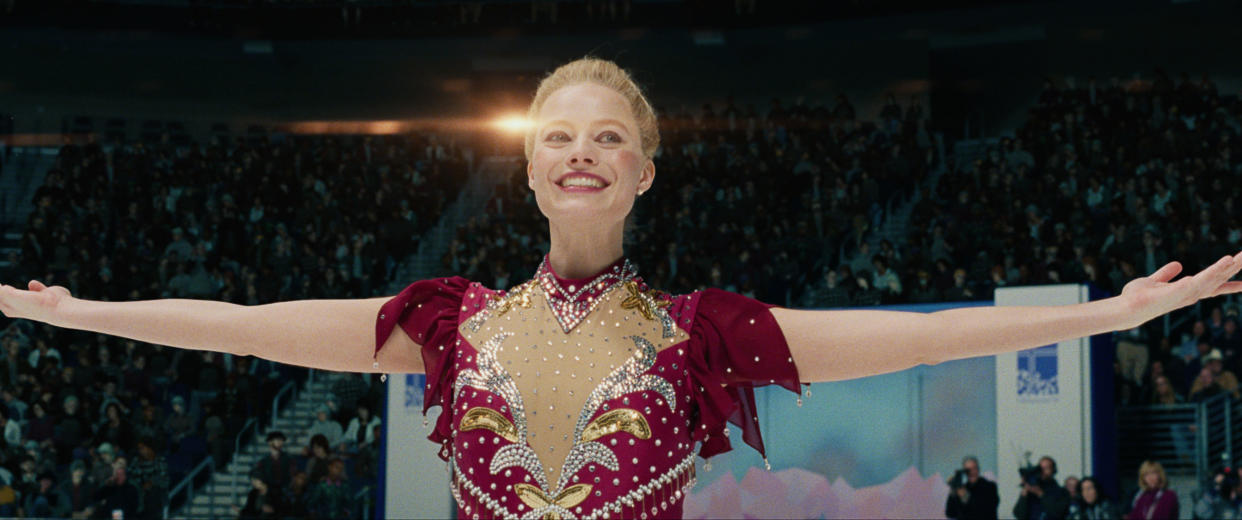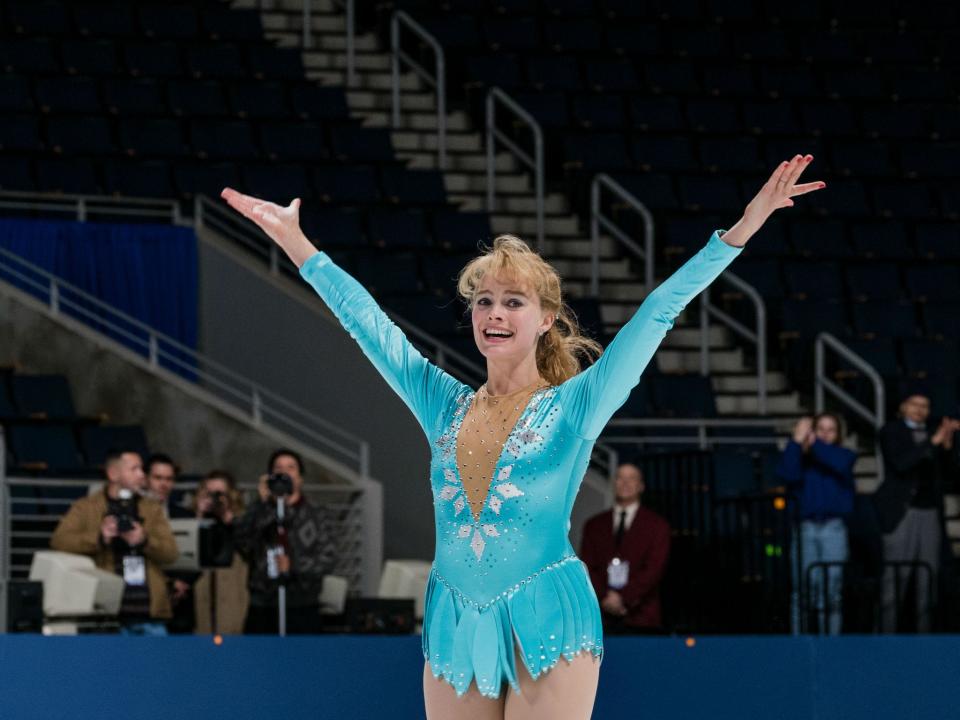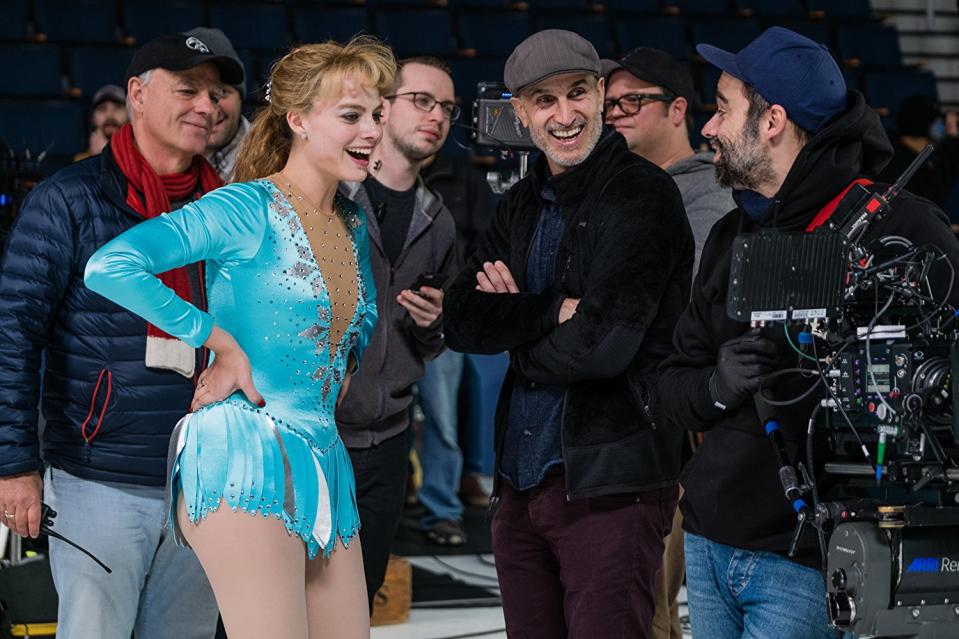How 'I, Tonya' made Margot Robbie skate like an Olympian

As Tonya Harding in the irreverent biographical drama I, Tonya, Margot Robbie had to embody one of the best-known Olympic figure skaters of all time — both on and off the ice. For the skating scenes that make up much of the film’s drama, director Craig Gillespie painstakingly re-created five of Harding’s performances, including her routines at the 1992 and 1994 Winter Olympics. Robbie, an Academy Award nominee for Best Actress, became a remarkably adept figure skater in a short amount of time. But to get her looking truly like an Olympian required a whole team of people. One was choreographer Sarah Kawahara, who adapted Harding’s routines for the big screen, taught Robbie to channel the athlete’s movements and style, and trained two professional skating doubles to execute Harding’s most difficult strokes and jumps. Another crucial person was VFX producer Juliet Tierney, whose effects house Eight VFX took the lead on the CG components of the competition scenes — notably, replacing the skating doubles’ faces with Robbie’s face. The week before the Oscars, Yahoo Entertainment spoke separately to Kawahara and Tierney about their work on I, Tonya to find out how these two women took the skating scenes to uncanny levels of realism. [The conversations below have been edited.]
Sarah Kawahara, choreographer: The producers had bought the life rights to Tonya’s story, so they really wanted to re-create her character and how she skated and what she skated to. So I did a lot of studying of her original footage.
Juliet Tierney, VFX producer: At the start, Craig Gillespie was hoping that we would be able to edit around her and not have too much face replacement. But he did absolutely know that face replacement was going to be part of the digital effects because, clearly, the skating is a huge part of the story. Tonya Harding was the first American woman ever to land a triple axel, and there are only about three people in the world currently that can land a triple axel, so we knew that was going to have to be done somehow in visual effects.
Kawahara: Tonya’s whole style of stroke, and her posture in her stroke, were very athletic. Her spins were very fast, and to find skaters that can spin really fast, they’re not a dime a dozen. So it was an interesting challenge.
Tierney: The routines are pretty intense. Even if you watch them now, they’re still pretty powerful and amazing. There was no way that an amateur was going to be able to achieve all of that so quickly. So yes, we did know that face replacement was going to be part of the deal.

Kawahara: In training Margot, first of all, it was important to just get the simple strokes of skating around the ice and getting out to the center and going over to your coach, all those simple movements. It was important to have her look like she’s done it all her life. And that’s easier said than done. Every [actor] wants to go through the usual steps that you have to go through, learning official stops and three turns and mohawks, but there really isn’t time when you’re doing a film on a short pre-production. So I have my little shortcuts. In working with the actor, I try to really adapt to their body rhythm to find how I am going to make this look comfortable on them. Margot told me she was a surfer, she leads with her left foot, and she also played a little bit of hockey when she was a teenager. So I knew she could probably do a hockey turn with her left foot leading and I turned that into her stop. Her official stop became a stop that actually we do on the ice, when you kind of come into conversation and you slow down and then all of a sudden you’re stopped, and you don’t even feel it, which is the whole point.
Tierney: We used two kinds of face replacement. There’s traditional 2-D face replacement, whereby you shoot a matching plate on green screen or blue screen of the actual actress’s face, and then you can digitally cut it out and stick it on the other person’s face. But for that to work, everything has to be perfect. You have to have exactly the right lighting, you have to have exactly the same angle, it has to be the same lens — there are so many factors that have to be perfect for that to be believable. For shots that are very close to the camera, we did use 2-D face replacement. For anything that we knew initially on the set was going to be a move that Margot couldn’t do, she would immediately go to the side and do a blue screen of her reactions.
Kawahara: I had to do five routines for her. The director wanted a full minute of the Jurassic Park piece, and I knew that they would be using the doubles for the spins and the jumps. But the actual choreography and getting her to move on a three-quarter shot was a real challenge. We really focused on the actual choreography and how she was going to learn it and turn from front to back, and look like she’s going into crossovers or coming out of a spin.
So Margot really did skate. She really learned her crossovers and stroking and she learned to go backwards. And on top of that, she did the actual choreography that I re-created from the original routine. Even though it was a three-quarter shot, if she was going forward, she had to go forward. If she had to turn back, she had to turn back. I mean, there was no cut to turn back. It had to be fluid from the waist up, and from the waist down it still had to be fluid, because it was supporting the top. So it is all an illusion, but she did work hard at it!

Tierney: When you’re shooting with the handheld cameras and Steadicams and moving in a face-paced visual sequence, that’s more difficult to be able to be able to replicate with 2-D. So then you know you have to go into a 3-D methodology. And to do that, you have to plan for it in advance. We were able to get a full portable CG scanning rig on set. In our behind the scenes video, you have Margo sitting in a kind of beautiful golden cage with lights. That’s a rig that has lots of cameras attached to it. They photograph her face at every kind of angle. And then we take those photographs into 3-D software and process the data to actually produce a CG-face head that can then be rigged and animated.
They take all the photographs with her doing nothing: completely neutral. And then they take photographs with different expressions, so she’ll lift up one eyebrow, she’ll open one eye, she’ll smile on one side, smile on both sides. So every basic facial expression is captured. And although that gives you some basic shapes, it’s not necessarily perfect enough, especially for some of the shots that are closer to the camera. So we then had to completely rig the digital model and hand-animate. We had a team of animators watching the performance of the body double, watching Margot’s performance in some other scenes, and literally hand-animating what her face would do in those shots.
Kawahara: Margot and I worked together for about four months, three to four times a week. And she would go to a trainer in between for building muscle because the body type [of a skater] is different; the muscles are in different places than the average person.
Tierney: We shot the data for the CG part on the set during February of last year, and then it was about a month to process the initial data out of the rig, and then it was about another month of taking that, hand-rigging it, starting to prep it for animation. And then the animators would have to spend a couple of days getting each shot initially right, and then they might have to do three or four versions depending on how it looks when you can see it actually lit and composited in the final shot.
And we were all aware that this was as great as an experience as it gets working on a film. The producers were all fantastic and they trusted Craig and us and left us to it. So we were under no pressure other than our own to make it great; we didn’t have layers of approvals. But obviously, it was scary, getting into it. We knew everybody trusted us and we were like, “Oh, we’ve got to make this work!” It was many, many sleepless nights in the heat of New York City last summer. And it was very nice to go to the Toronto Film Festival and see it on the big screen for the first time and go, “OK, we actually pulled this off and people are asking us nice questions about how we did it!”
The shot we’re most proud of is right at the end when she’s at Lillehammer and her boot breaks, and there’s a three-minute sequence which is one seamless shot of her starting to perform and then breaking down. It’s a three-minute shot and it’s made up of three plates. So the first plate and the last plate are the actual Margot skating, and the middle one is the body double, and it’s completely face replacement. That was our most challenging one by far because it’s the same shot with the face replaced and the actual Margot in the same shot. So that one had to be perfect.

Kawahara: In 1995, I did a TV special for Nancy Kerrigan — right after the incident. It was a tough time; she was emotionally very fragile. We really wanted to expand her horizons and show different sides of her because everyone only knew her from the Olympics. And that was hard for her at the time because she just wanted to be safe. She just wanted to do something she knew. She was much more accepting of it after the fact. Years later, she came back and thanked me.
And I’d met Tonya a few times. As a matter of fact, her manager at the time, Michael Rosenberg, he asked me if I would work with her. And it just wasn’t the right time for me, because I was working with so many other people: Surya Bonaly, Oksana Baiul, Kristi Yamaguchi. And it just didn’t seem like the right time for me to work with her. So it was kind of fun that after all these years, it’s come full circle — not working with her directly, but working with who she was. And we re-met, of course, at the premiere.
I was kind of nervous about the whole film, really. It’s the kind of thing where you’re not sure, should you hide? Is it going to be OK? [Laughs.] And so I was delighted when I saw it and said, “It’s OK, I can show my face!” I thought it was handled really well. And oftentimes when you work on a film, so much of your work ends up on the cutting room floor. But everything made it in! I was so thrilled for the doubles, and I was thrilled for Margot. It was great that all the work that we put into it made it onto the screen.
I, Tonya is now on digital and will be available on Blu-ray March 13.
Watch a deleted scene from I, Tonya:
Read more from Yahoo Entertainment:

